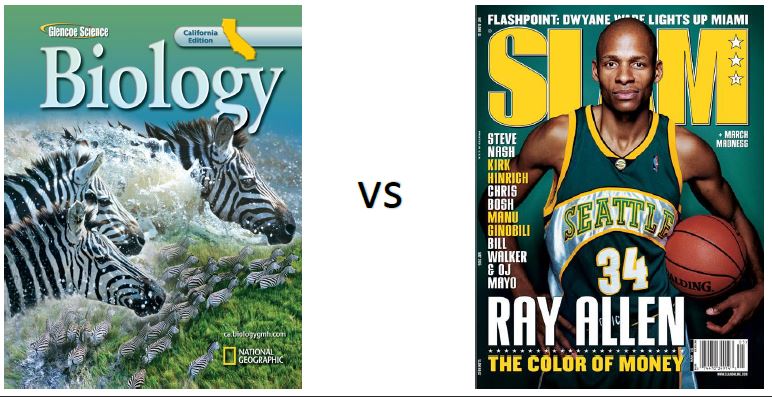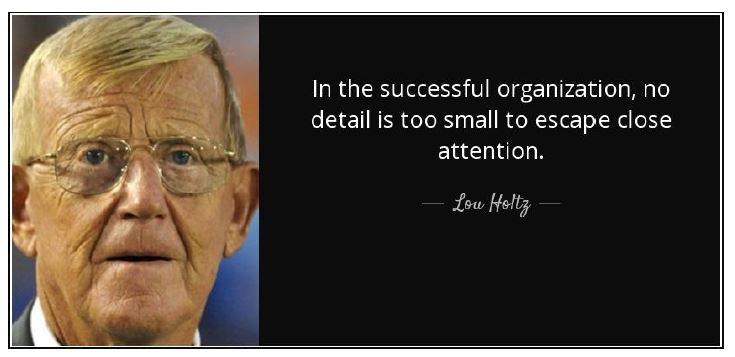
This article was contributed by:
Justin Matthew Brandt
[email protected]
CoachJB.weebly.com
Here is a link to his YouTube channel
Here is a link to his Instagram
Attention to detail and paying attention in general is a problem that all coaches battle with their athletes during practice, film sessions, games, etc.
Whether it’s the occasional side conversation while you’re speaking, wandering eyes to the floor or the opposite sex being present in the gymnasium, you have had something challenge their attention from you at some point in time.
The question we will attempt to answer today is, how can we effectively keep our athlete’s attention when it is needed?

I do not believe there are a lot of people out there that will challenge the statement that people tend to focus their attention on the topics they are interested in. Many times we find that our student athletes struggle with the little details because they are not fun or entertaining. Take the example provided below. Most students see a biology book and roll their eyes because they see it as a required class and it can be challenging. What they do not see is an opportunity to get a good grade in an important class that will boost their GPA and increase their chances at getting into the school they want to attend or eventually landing them the job they want.

Now I am NOT suggesting that everything we coach/teach needs to be fun or entertaining. The fact is that the majority of the jobs in the world do not involve fun games and at some point in their lives they need to figure out how to continue to focus and be productive. With the same argument, us as coaches and/or teachers cannot use the same excuse of their complacency to not help this generation of student athletes. Sometimes, it is our own laziness or comfort of conventionalism that hinders us from helping them. While we may very well want to say to them, “suck it up and pay attention, that’s what I had to do” you may find your job a bit easier if you meet them halfway.
Studies show that 78% of Americans aged 12 to 17 have a cell phone, 95% use the internet and 81% use social media outlets. This means that well over half of that teen population that we work with spends the majority of their time gathering information from entertaining sources. So the information you are trying to convey to them via a ten-minute talk, it probably isn’t reaching home.
65% of teens report that they have either participated in, or have been affected by, cyber bullying. This takes us into a complete different issue, conflict resolution. Ask the majority of people what a conflict is and their mind goes to something serious or even physical in nature. However, conflict by definition is a disagreement (n.) or something to be incompatible or at variance (v.). Is this not what we see whenever we redirect an athlete or inform them they are not performing the way we expect them to?
The issue here lies in the fact that they simply are not used to communicating and coping with criticism face to face where appropriate and immediate reaction is required. When presented with a challenging statement via an electronic source, users are given the safety net of time and privacy to respond with freedom in private. Consequences are dealt in a delayed format which promotes bravery in both actions and speech. Think about this the next time you try to challenge an athlete on their performance and they give you that look as if to say, “Who me!?”

So how can we help our athletes focus better and get most out of them?
Firstly, it should be noted that the goldfish won the competition when it comes to adults’ attention span when browsing the internet, so don’t stress too hard over the fun fact above. However, the first 8 seconds is CRITICAL to capturing the audience’s attention. If you do not grab their attention in the first 8 seconds, you’re going to have a big struggle on your hand. Movie makers have known this for years and that’s why they introduce a new stimulus every few seconds to keep their audience’s attention throughout the entire movie. This is why during this article you have seen the introduction of either new fonts, colors or pictures every few seconds or minutes.
*Fun fact – it took teens on average 6.3 seconds to read the first sentence of this article*
The perfect adult attention span lasts around 20 minutes with the average down to around 5 minutes. However, scientists have noticed that your attention tends to dwindle or reset every couple of minutes. So in summation, MAKE YOUR INFORMATION SHORT AND TRANSFERABLE!
Great research Coach, but how do I actually apply this on the court or in the classroom?
You can apply the information provided in this article in a variety of ways. The easiest and least invasive to your coaching/teaching strategies to apply this knowledge is to simply change your tone or positioning while speaking. If you have been explaining something for more than a couple of minutes, and you have other coaches present, get someone else to pick up in the middle of the talk. If you have already done this, another simple way to keep their attention is to change your court location. Doing this not only provides a stimulus of eye focus location, but it causes changes in heart rate which naturally demands the body’s attention.
For a more challenging and invasive approach of how you can better your practices, review the following practice plans.
Editor’s Note from Brian. This is an EXAMPLE to give you thinking about how your practice times for your skills and drills can be broken up to include less time for each segment and to include more segments and more transitions. This is not an exact plan that is meant for you to use as is. Also, regarding the break in the second plan: Our games have timeouts, halftimes, or quarter and official’s monitor reviews depending on the level that you coach. Since those short breaks are a part of our games, it is worth considering including them in practice.
Traditional Practice Plan
10 minutes Warm Up
20 minutes Set Plays
15 minutes Press Offense
15 minutes Press Defense
60 Minutes Total Time
Attention Based Practice Plan
10 minutes Warm Up
6 minutes Set Plays Basket #1
2 minutes 1 on 1 All Baskets
6 minutes Set Plays Basket #2
2 minutes 2 on 2 All Baskets
6 minutes Press Offense Full Court, 2 sets of Retreat Dribble Series Sideline
6 minutes Press Offense Full Court
3 minutes Break/Shoot Around
4 minutes Press Defense Full Court, 2 sets of Defensive Slides All Baskets
4 minutes Press Defense Full Court, 2 sets of Triangle Closeouts All Baskets
3 minutes Press Defense Full Court
58 minutes Total Time
As you can see both practice plans have an agenda and will accomplish their tasks for the day. However, as you can see from the attention based practice plan, the team has accomplished their tasks, they have promoted personal growth while focusing on a team oriented workout, they have changed locations, promoted a demand for attention changes (one activity to the next) and allowed time for attention resets no longer than six minutes.
One last point that I would like to make is focused on the highlighted section above, “promoted a demand for attention changes”. Many coaches would deem this as a little chaotic for the practice liking and rightfully so. However, I would like to remind coaches that basketball is a very fast paced and chaotic sport. During the 2015-2016 NCAA Division I season, the team that averaged the most amount of possessions per game was the Citadel with 83ppg. The lowest team, the University of Virginia, had 62.7ppg, that’s a league median of 71.1 possessions per game. With those statistics in mind, would you rather have a “traditional practice” that transitioned from one activity to the next four times or an “attention based practice plan” that transitioned 14 times?
Attention to detail or paying attention in general is truly a characteristic that we all struggle with in today’s society. Whether it be us as coaches trying to demand our student athletes’ attention, or us trying to pay attention when we’re sitting through a meeting. If we have the opportunity to enhance our attention skills, we should meet that head on as it will help us be more successful down the road. In closing I ask you to remember what Shane Battier stated about analytics, “Analytics aren’t something that you solely rely on, they are a tool to your success.”







